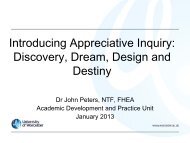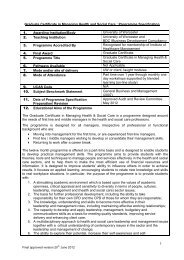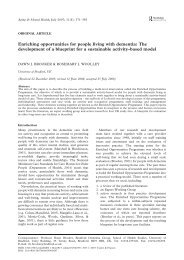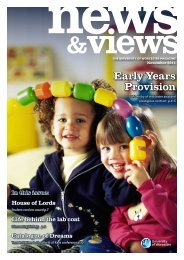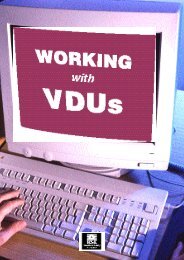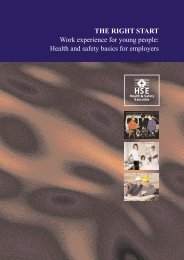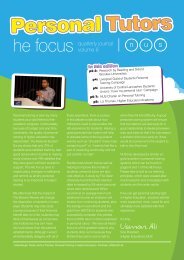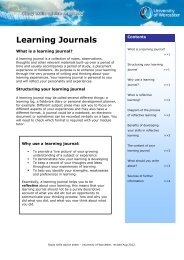The extent to which the use of Accounting Software and Excel is ...
The extent to which the use of Accounting Software and Excel is ...
The extent to which the use of Accounting Software and Excel is ...
Create successful ePaper yourself
Turn your PDF publications into a flip-book with our unique Google optimized e-Paper software.
<strong>The</strong> <strong>extent</strong> <strong>to</strong> <strong>which</strong> <strong>the</strong> <strong>use</strong> <strong>of</strong> <strong>Accounting</strong> S<strong>of</strong>tware <strong>and</strong> <strong>Excel</strong><br />
<strong>is</strong> incorporated in HE Accountancy Courses<br />
Stephen Hicks <strong>and</strong> Sue Barnes<br />
University <strong>of</strong> Worcester<br />
(s.hicks@worc.ac.uk)<br />
Introduction<br />
<strong>The</strong> accounting practitioner will almost inevitably <strong>use</strong> accounting s<strong>of</strong>tware packages<br />
in <strong>the</strong>ir working life. <strong>The</strong> first aim <strong>of</strong> th<strong>is</strong> project was <strong>to</strong> review <strong>the</strong> <strong>extent</strong> <strong>to</strong> <strong>which</strong><br />
such skills are taught as part <strong>of</strong> HE accounting courses <strong>and</strong> <strong>the</strong>n propose whe<strong>the</strong>r<br />
<strong>and</strong> how such skills should be included in UMS modules as part <strong>of</strong> <strong>the</strong> proposed<br />
degree in Accountancy in Worcester Business School. <strong>The</strong> research motivation here<br />
was simply <strong>to</strong> ensure that our curriculum was fit for purpose.<br />
A second aim was <strong>to</strong> review <strong>the</strong> <strong>use</strong> <strong>of</strong> <strong>Excel</strong> in teaching accounting courses. As with<br />
accounting s<strong>of</strong>tware, <strong>the</strong> <strong>use</strong> <strong>of</strong> <strong>Excel</strong> or similar spreadsheets <strong>is</strong> part <strong>and</strong> parcel <strong>of</strong> an<br />
accountant’s working life. In addition some seminar activities are based in computer<br />
labs <strong>and</strong> depend on a certain level <strong>of</strong> expert<strong>is</strong>e in using <strong>Excel</strong> <strong>to</strong> solve accounting<br />
problems. Marriott (2004) d<strong>is</strong>cusses some <strong>of</strong> <strong>the</strong> pedagogical benefits <strong>of</strong> using<br />
spreadsheets <strong>to</strong> enable learning <strong>of</strong> accounting concepts, stressing <strong>the</strong> role <strong>of</strong><br />
experiential learning. <strong>The</strong> research motivation here was tw<strong>of</strong>old; <strong>to</strong> give some<br />
measure <strong>of</strong> students’ expert<strong>is</strong>e in <strong>Excel</strong> for business <strong>use</strong> <strong>and</strong> <strong>to</strong> investigate whe<strong>the</strong>r<br />
learning outcomes were comprom<strong>is</strong>ed by <strong>the</strong> level <strong>of</strong> expert<strong>is</strong>e.<br />
D<strong>is</strong>cussion<br />
1 <strong>Accounting</strong> S<strong>of</strong>tware<br />
No reliable analys<strong>is</strong> <strong>of</strong> <strong>the</strong> <strong>extent</strong> <strong>of</strong> <strong>the</strong> <strong>use</strong> <strong>of</strong> accounting s<strong>of</strong>tware has been found. It<br />
may be assumed that larger companies <strong>and</strong> not for pr<strong>of</strong>it organ<strong>is</strong>ations make <strong>use</strong> <strong>of</strong><br />
accounting s<strong>of</strong>tware <strong>to</strong> maintain <strong>the</strong>ir accounting records, but it <strong>is</strong> possible <strong>of</strong> course<br />
for smaller organ<strong>is</strong>ations <strong>to</strong> account perfectly well without such an approach. Having<br />
said that, one supplier <strong>of</strong> s<strong>of</strong>tware aimed at <strong>the</strong> smaller organ<strong>is</strong>ation, Sage, report<br />
over 760,000 UK installations. On th<strong>is</strong> bas<strong>is</strong>, it seems likely that <strong>the</strong> pr<strong>of</strong>essional<br />
accountant will be using an accounting s<strong>of</strong>tware package as part <strong>of</strong> <strong>the</strong>ir pr<strong>of</strong>essional<br />
role. Incorporation <strong>of</strong> training in <strong>use</strong> <strong>of</strong> an accounting s<strong>of</strong>tware package would<br />
provide some preparation for th<strong>is</strong> role but it would also provide a fur<strong>the</strong>r means <strong>of</strong><br />
teaching accounting skills. One could env<strong>is</strong>age students being set an accounting<br />
case study, whereby <strong>the</strong>y have <strong>to</strong> record transactions, produce accounting<br />
information <strong>and</strong> comment/analyse <strong>the</strong> same. Th<strong>is</strong> might provide a rich learning<br />
environment, including both procedural <strong>and</strong> functioning knowledge, <strong>and</strong> provide <strong>the</strong><br />
outputs needed for assessment. Th<strong>is</strong> in itself seems a strong enough reason <strong>to</strong><br />
incorporate <strong>use</strong> <strong>of</strong> an accounting package in our syllabus. <strong>The</strong>re might also be <strong>the</strong><br />
opportunity for inter-modular linkages, for example <strong>the</strong> transactions <strong>use</strong>d in a<br />
financial reporting module being <strong>the</strong> bas<strong>is</strong> for work in an auditing module.<br />
A fur<strong>the</strong>r point <strong>is</strong> that if we are <strong>to</strong> <strong>of</strong>fer an accounting degree we need <strong>to</strong> ensure it <strong>is</strong><br />
relevant <strong>and</strong> competitive compared <strong>to</strong> <strong>the</strong> degrees <strong>of</strong>fered by o<strong>the</strong>r Universities. To<br />
investigate th<strong>is</strong>, UCAS l<strong>is</strong>tings were <strong>use</strong>d <strong>to</strong> identify Universities that currently <strong>of</strong>fer<br />
an accounting degree. <strong>The</strong> web sites <strong>of</strong> <strong>the</strong>se Universities were <strong>the</strong>n per<strong>use</strong>d <strong>to</strong><br />
identify a suitable contact involved with <strong>the</strong> accounting degree. Initially, it had been<br />
hoped that information on <strong>the</strong> teaching <strong>of</strong> accounting s<strong>of</strong>tware might be d<strong>is</strong>cerned<br />
from modular information, but th<strong>is</strong> did not prove fruitful <strong>and</strong> so was ab<strong>and</strong>oned. A
<strong>to</strong>tal <strong>of</strong> 62 contacts was harvested <strong>and</strong> a simple questionnaire admin<strong>is</strong>tered using<br />
Survey Monkey. <strong>The</strong> two questions relevant here are as follows.<br />
Q1<br />
Q2<br />
Do you <strong>use</strong> teach <strong>the</strong> <strong>use</strong> <strong>of</strong> specific accounting s<strong>of</strong>tware in your UG<br />
accounting degree programme(s). Response - Y or N.<br />
Please enter <strong>the</strong> s<strong>of</strong>tware package <strong>use</strong>d. Response - Free text.<br />
Ten responses were received. Seven universities answered yes <strong>to</strong> Q1 <strong>and</strong> three<br />
answered no. Of <strong>the</strong> seven who responded, <strong>the</strong>y all reported using Sage s<strong>of</strong>tware at<br />
Q2. In addition, it <strong>is</strong> known that three Universities known <strong>to</strong> <strong>the</strong> author <strong>use</strong>s Sage<br />
s<strong>of</strong>tware as part <strong>of</strong> its accounting programme.<br />
<strong>The</strong> evidence from <strong>the</strong> survey <strong>is</strong> that teaching <strong>of</strong> <strong>the</strong> <strong>use</strong> <strong>of</strong> accounting s<strong>of</strong>tware <strong>is</strong><br />
commonplace <strong>and</strong> that Sage <strong>is</strong> <strong>the</strong> product taught. Given <strong>the</strong> pedagogic<br />
considerations outlined above, it seems we should actively investigate incorporating<br />
<strong>the</strong> <strong>use</strong> <strong>of</strong> Sage in our accountancy syllabus.<br />
2 <strong>Excel</strong><br />
<strong>The</strong> European Spreadsheet R<strong>is</strong>ks Interest Group (www.eusprig.org ) provides<br />
information on <strong>the</strong> <strong>use</strong> <strong>of</strong> spreadsheets <strong>and</strong> attendant problems. <strong>The</strong> Spreadsheets<br />
Productivity Research Interests Group (www.sprig.section.informs.org) serves a<br />
similar purpose for <strong>the</strong> USA. In general, <strong>the</strong>se groups highlight <strong>the</strong> ubiqui<strong>to</strong>us <strong>use</strong> <strong>of</strong><br />
spreadsheets <strong>and</strong> <strong>the</strong> problems that may ar<strong>is</strong>e, from areas as diverse as <strong>the</strong> City <strong>of</strong><br />
London <strong>to</strong> medical diagnos<strong>is</strong>. Th<strong>is</strong> suggests <strong>the</strong> need <strong>to</strong> at least make students<br />
aware <strong>of</strong> some <strong>the</strong> pitfalls <strong>of</strong> spreadsheet <strong>use</strong> <strong>and</strong> <strong>of</strong> good practice, even if we do not<br />
make time in <strong>the</strong> curriculum for study th<strong>is</strong> area. S<strong>to</strong>ner (2009) has also commented<br />
on <strong>the</strong> low level <strong>and</strong> slow improvement in spreadsheet skills.<br />
To provide some indication <strong>of</strong> student <strong>use</strong> <strong>of</strong> <strong>Excel</strong> in a business situation, a group <strong>of</strong><br />
fifteen Year 2 students studying management accounting agreed <strong>to</strong> respond <strong>to</strong> a<br />
questionnaire <strong>and</strong> <strong>to</strong> submit spreadsheets <strong>the</strong>y had prepared as part <strong>of</strong> a seminar<br />
exerc<strong>is</strong>e <strong>to</strong> be reviewed by a one <strong>of</strong> <strong>the</strong> lecturers involved with <strong>the</strong> seminar. <strong>The</strong><br />
questionnaire <strong>and</strong> summar<strong>is</strong>ed responses are set out below. In addition, <strong>the</strong><br />
questionnaire <strong>use</strong>d <strong>to</strong> ascertain teaching <strong>of</strong> accounting packages included two<br />
questions relating <strong>to</strong> spreadsheets.<br />
From <strong>the</strong> point <strong>of</strong> view <strong>of</strong> spreadsheet good practice, two main points ar<strong>is</strong>e. Q9<br />
highlights lack <strong>of</strong> experience in linking different workbooks, <strong>and</strong> Q10 where students<br />
were essentially “embedding a constant” – <strong>the</strong> rate <strong>of</strong> VAT. Both <strong>of</strong> <strong>the</strong>se areas are<br />
noted by <strong>the</strong> European Spreadsheet R<strong>is</strong>ks Interest Group as being a common source<br />
<strong>of</strong> problems.<br />
<strong>The</strong> latter point <strong>of</strong> embedding constants was also observed by lecturer review <strong>of</strong><br />
spreadsheets produced by students in <strong>the</strong> seminar session, where 10 out 14<br />
students made th<strong>is</strong> error. One instance was embedding <strong>the</strong> VAT rate. Ano<strong>the</strong>r<br />
instance was a constant for proportion <strong>of</strong> cash from sales received over a period <strong>of</strong><br />
months. <strong>The</strong> seminar activity required students <strong>to</strong> model <strong>the</strong> impact on cash flow if<br />
th<strong>is</strong> proportion changed (analogous <strong>to</strong> a real world situation <strong>of</strong> cus<strong>to</strong>mers not paying<br />
on time). By embedding th<strong>is</strong> constant, many students ran out <strong>of</strong> time <strong>and</strong> could not<br />
investigate th<strong>is</strong>, as editing <strong>the</strong> embedded constant was quite time consuming (<strong>and</strong><br />
prone <strong>to</strong> error, if any instance was m<strong>is</strong>sed).<br />
<strong>The</strong> questions <strong>and</strong> responses <strong>to</strong> <strong>the</strong> questionnaire sent <strong>to</strong> Universities were as<br />
follows.
Q1 Do you require students <strong>to</strong> <strong>use</strong> spreadsheets in<br />
seminars/lectures?<br />
Response Never = 1, Sometimes = 6, Often = 2. No response = 1<br />
Q2 Do you feel students have spreadsheet skills appropriate <strong>to</strong> <strong>the</strong><br />
needs <strong>of</strong> your course?<br />
Response Deficient = 2, Adequate = 6, Higher than needed = 1. No response = 1.<br />
<strong>The</strong>se results demonstrate that spreadsheets are <strong>use</strong>d in <strong>the</strong> teaching <strong>of</strong> accounting,<br />
but <strong>the</strong> response <strong>to</strong> <strong>the</strong> level <strong>of</strong> skills question <strong>is</strong> somewhat at odds with <strong>the</strong> findings<br />
<strong>of</strong> <strong>the</strong> work with <strong>the</strong> seminar group.<br />
Conclusion<br />
As regards accounting s<strong>of</strong>tware, a recogn<strong>is</strong>ed package, probably Sage, should be<br />
included in <strong>the</strong> curriculum <strong>to</strong> facilitate student expert<strong>is</strong>e in its <strong>use</strong> <strong>and</strong> as a means <strong>of</strong><br />
learning accounting.<br />
As regards <strong>Excel</strong> (or spreadsheets in general) we should introduce students <strong>to</strong> <strong>the</strong><br />
potential problems <strong>of</strong> using spreadsheets <strong>and</strong> help students <strong>to</strong> prepare for seminar<br />
sessions where spreadsheets are <strong>use</strong>d as a <strong>to</strong>ol <strong>to</strong> increase learning <strong>of</strong> <strong>the</strong><br />
accounting <strong>is</strong>sue, ra<strong>the</strong>r than <strong>the</strong> spreadsheet <strong>is</strong>sue.<br />
References<br />
Marriott, Neil. (2004) Using computerized business simulations <strong>and</strong> spreadsheet<br />
models in accounting education: a case study. <strong>Accounting</strong> Education, 13, 55-70.<br />
S<strong>to</strong>ner, Gregory. (2009) <strong>Accounting</strong> Students' IT Application Skills over a 10-year<br />
Period. <strong>Accounting</strong> Education, 18 (1), 7-31.<br />
Appendix - Questionnaire <strong>and</strong> Responses<br />
Student responses – 14 respondents<br />
To help us underst<strong>and</strong> students’ knowledge <strong>of</strong> spreadsheet <strong>and</strong> accounting s<strong>of</strong>tware<br />
for <strong>use</strong> in accountancy modules, please complete <strong>the</strong> following:<br />
1 Please l<strong>is</strong>t below all <strong>the</strong> spreadsheet s<strong>of</strong>tware you have <strong>use</strong>d in <strong>the</strong><br />
past:<br />
<strong>Excel</strong> 13<br />
Lotus 123 2<br />
Super calc 1<br />
SPSS 1<br />
Sage 1<br />
Access 3<br />
Open Office 3<br />
Word 1<br />
Powerpoint 1<br />
5 respondents – <strong>the</strong> only s<strong>of</strong>tware mentioned was <strong>Excel</strong><br />
1 respondent – did not mention <strong>Excel</strong> but included SPSS <strong>and</strong> Access<br />
2 respondents – had <strong>use</strong>d <strong>Excel</strong> <strong>and</strong> Open Office spreadsheet s<strong>of</strong>tware<br />
2 respondents – had <strong>use</strong>d <strong>Excel</strong> <strong>and</strong> Lotus<br />
2 Please give an example <strong>of</strong> a calculation or formulae you have <strong>use</strong>d<br />
successfully in <strong>the</strong> past:
SUM = 11<br />
AVERAGE = 2<br />
AVG = 1<br />
MEAN = 1<br />
TOTAL =1<br />
SQRT = 1<br />
MED = 1<br />
RAND = 1<br />
MULT = 1<br />
AUTO COMPLETION = 1<br />
MULTIPLY AND EQUALS = 1<br />
AN EXAMPLE OF ALGEBRA = 1<br />
9 respondents gave one example, 6 <strong>of</strong> <strong>the</strong>se being SUM<br />
3 When entering text in<strong>to</strong> a spreadsheet, for what purpose has th<strong>is</strong><br />
been?<br />
Fuel economy<br />
Personal accounts<br />
Tables <strong>and</strong> graphs<br />
Naming cells<br />
Notes<br />
Variable names<br />
Comments<br />
Explanations<br />
Work hours<br />
L<strong>is</strong>ts <strong>and</strong> tables<br />
Titles for tables / headings<br />
Data entry<br />
Budgeting<br />
As part <strong>of</strong> a question or solution<br />
Sorting by number or name<br />
Range names<br />
University work<br />
Finance lectures: income statements,<br />
balance sheets<br />
Took business dec<strong>is</strong>ion making module<br />
in first year = 1<br />
assignments<br />
4 Thinking about <strong>the</strong> functions <strong>use</strong>d in spreadsheet s<strong>of</strong>tware, l<strong>is</strong>t <strong>the</strong><br />
ones you have <strong>use</strong>d successfully in <strong>the</strong> past:<br />
Sq root 2<br />
Aveg = 4<br />
Sum = 4<br />
Mode = 3<br />
Median = 2<br />
Mean = 3<br />
Range = 3<br />
Macros = 2<br />
If = 2<br />
R<strong>and</strong> = 2<br />
Lookup =2<br />
Charts / graphs / chart wizard = 8<br />
absolute cell reference = 2<br />
St<strong>and</strong>ard deviation =2<br />
Sort data<br />
Add subtract<br />
Charts<br />
Int<br />
Equations<br />
Calculus<br />
Cott<br />
Max<br />
Min<br />
tables
5 Thinking about <strong>the</strong> functions <strong>use</strong>d in spreadsheet s<strong>of</strong>tware, <strong>is</strong> <strong>the</strong>re<br />
anything you would have liked <strong>to</strong> have achieved, but were<br />
unsuccessful? What were you trying <strong>to</strong> achieve? Have you any<br />
suggestions for why th<strong>is</strong> was not successful?<br />
• Locking formula by using $ - I find<br />
th<strong>is</strong> most confusing<br />
• Help pages are no good<br />
• Chart functions – trying <strong>to</strong> input data<br />
<strong>to</strong> formulate a chart – <strong>the</strong> chart did<br />
not come out how I wanted it <strong>to</strong><br />
• Entering <strong>the</strong> wrong formulae<br />
• If<br />
• Lookup<br />
• Functions are no <strong>use</strong> <strong>to</strong> me<br />
• Different chart functions<br />
• Different <strong>to</strong>ols that can explain graph<br />
data more effectively<br />
• Nothing<br />
• None – anything I needed <strong>to</strong> do was<br />
explained by tu<strong>to</strong>r<br />
• No – 3<br />
• Don’t remember<br />
• I know <strong>the</strong>re are lots <strong>of</strong> things I’m<br />
not aware <strong>of</strong><br />
• No, help files <strong>and</strong> <strong>the</strong> internet have<br />
been invented for that<br />
6 Now consider ‘accountancy’ – for what purposes have you <strong>use</strong>d a<br />
spreadsheet in th<strong>is</strong> context?<br />
For assignments only<br />
Producing account for different companies<br />
Inserting sales data in<strong>to</strong> retail s<strong>of</strong>tware<br />
To keep track <strong>of</strong> business sales, cash/credit<br />
At work – wages, sage, checking invoices<br />
Spreadsheets<br />
Break even<br />
income statements<br />
balance sheets<br />
Drawing financial ratios<br />
Budgets<br />
End <strong>of</strong> financial year<br />
Financial statements<br />
Data tables<br />
charts<br />
7 Have you <strong>use</strong>d s<strong>of</strong>tware <strong>to</strong> create charts?<br />
If yes, please l<strong>is</strong>t <strong>the</strong> types <strong>of</strong> charts you have created <strong>and</strong> for what<br />
purpose. If no, please indicate <strong>the</strong> types <strong>of</strong> charts you have heard<br />
<strong>of</strong>.<br />
Basic charts for assignments - using<br />
data provided in brief<br />
Results <strong>of</strong> card game <strong>to</strong>urnaments<br />
For school, presentations, modules<br />
Different diagrams<br />
Diagrams for economics<br />
Pie<br />
Bar<br />
Line<br />
Stats<br />
scatter<br />
Percentage charts<br />
Horizontal charts<br />
H<strong>is</strong><strong>to</strong>grams<br />
8 Have you any experience <strong>of</strong> ‘linking’ separate workbooks? If so,<br />
what was <strong>the</strong> purpose <strong>and</strong> context?<br />
No = 9<br />
Tried unsuccessfully<br />
I have attempted <strong>to</strong>, but it ended in a bit<br />
<strong>of</strong> a mess<br />
We had a master file for data <strong>and</strong> <strong>the</strong>n<br />
o<strong>the</strong>r workbooks have accessed th<strong>is</strong><br />
I had data in one workbook <strong>and</strong> wanted<br />
<strong>to</strong> <strong>use</strong> that data in ano<strong>the</strong>r<br />
Linking accounts <strong>of</strong> separate companies
9 Have any <strong>of</strong> <strong>the</strong> modules you have studied at university equipped<br />
you <strong>to</strong> <strong>use</strong> spreadsheets? What module(s) <strong>and</strong> in what way?<br />
Business Dec<strong>is</strong>ion Making = 2<br />
• Fur<strong>the</strong>r functions <strong>and</strong> equations <strong>and</strong><br />
greater awareness <strong>of</strong> what <strong>Excel</strong> <strong>is</strong><br />
capable <strong>of</strong> (business dec<strong>is</strong>ion<br />
making)<br />
• Forecasting, budgeting<br />
• Inputting data <strong>of</strong> petrol usage<br />
• To perform calculations for different<br />
sorts <strong>of</strong> data<br />
• Used <strong>to</strong> aid managers dec<strong>is</strong>ions<br />
• Trends, patterns, extrapolation<br />
• To make assuptions<br />
•<br />
• Some spreadsheet training would be<br />
good. It always ends up trail <strong>and</strong><br />
error.<br />
No = 2<br />
Sports Physiology = 1<br />
• input data, calculate mean, st<strong>and</strong>ard<br />
deviation <strong>and</strong> create graphs<br />
<strong>Accounting</strong> modules<br />
• <strong>Accounting</strong> statements<br />
• Finance – balance sheets, pr<strong>of</strong>it / loss<br />
accounts<br />
10 If your spreadsheet had <strong>to</strong> allow for VAT, how would you go about<br />
incorporating th<strong>is</strong> in<strong>to</strong> a spreadsheet?<br />
By using a separate formula column <strong>to</strong><br />
calculate VAT <strong>and</strong> <strong>to</strong>tals<br />
Using formulas <strong>and</strong> calculations<br />
Y x 1.15<br />
Amount x 1.15 (15% VAT) = <strong>to</strong>tal amount<br />
Insert row with calculation eg B3*0.15 <strong>to</strong><br />
give VAT figure <strong>of</strong> sales price <strong>and</strong><br />
include th<strong>is</strong> in<strong>to</strong> <strong>to</strong>tal cost/price<br />
And finally, what ma<strong>the</strong>matics qualification(s) do you hold?<br />
CSE <strong>and</strong> O level<br />
GCSE <strong>and</strong> A level<br />
GCSE (grades C <strong>and</strong> B where indicated)<br />
Advanced level<br />
Finn<strong>is</strong>h A level<br />
Overseas equivalent <strong>of</strong> GCSE



